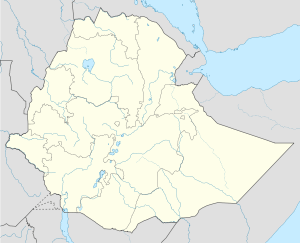Qwiha
| Qwiha | |
|---|---|
 Qwiha | |
| Coordinates: 13°29′N 39°38′E / 13.483°N 39.633°E | |
| Country | Ethiopia |
| Region | Tigray |
| Zone | Debub Misraqawi (Southeastern) |
| District | Enderta |
| Elevation | 2,247 m (7,372 ft) |
| Population (2005) | |
| • Total | 12,543 |
| Time zone | EAT (UTC+3) |
Qwiha (also Kuha or Kwiha) is a town located in northern Ethiopia. The name comes from the local word for willows, which are abundant in the area.[1] Located in the Debub Misraqawi (Southeastern) Zone of the Tigray Region, it lies 9 kilometers east of Mek'ele straddling the highway that leads to Addis Ababa. It has a latitude and longitude of 13°28′37″N 39°32′42″E / 13.47694°N 39.54500°ECoordinates: 13°28′37″N 39°32′42″E / 13.47694°N 39.54500°E with an elevation of 2247 meters above sea level.
Overview
Qwiha is the administrative center of the Enderta woreda. It had telephone service at least as early as 1956, when it is reported that the only hotel in town had the only telephone.[2]
The airport of Mekelle, Alula Aba Nega Airport is located within the administrative boundaries of Qwiha. In Qwiha, the main paved road from Addis Ababa takes a sharp turn left to Mek'ele. The old road to Asmara, still bearing the "National road n°1" label, keeps heading north to the village of Maymagden and Wukro but is not asphalted. A local road starts in Qwiha linking the eastern tabias of Arato and Derge Agen to the woreda center. Seven kilometers south of Qwiha a regional road heading to Shiket and the Afar Region diverts from the national highway.
History
On the northern edge of town are ruins, including a set of monolithic pillars. The ruins were first described by Nathaniel Pearce in the early 19th century, which included the presence of inscriptions. he also mentions the presence of a sacred spring whose waters "afflicted with disease resort from far and near to bathe."[1] There is also a tradition that the ruins were part of a church dedicated to the Ethiopian saint Chirqos and destroyed by Imam Ahmad Gragn. Although no other remains of this structure has been recorded, a more recent church stands nearby and "grave digging has exposed rough walls and possibly Aksumite pottery."[3]
The Guido describes Qwiha in 1938, during the Italian occupation, as having a small Italian settlement below the center of town, and little north of the pass a small church of San Francesco da Páola built by an Italian military unit.[2] The town was occupied by the Woyane during their rebellion against the Ethiopian government in late 1943.[4]
Demographics
Based on figures from the Central Statistical Agency in 2005, Qwiha has an estimated total population of 12,543, of whom 5,644 were males and 6,899 were females.[5] The 1994 census reported it had a total population of 9,867 of whom 4,336 were males and 5,531 were females. It is one of two towns in Enderta woreda.
Notes
- ↑ 1.0 1.1 Nathaniel Pearce, (J.J. Halls, editor), The Life and Adventures of Nathaniel Pearce (London, 1831), vol. 1 pp. 121-4
- ↑ 2.0 2.1 "Local History in Ethiopia" The Nordic Africa Institute website (accessed 10 January 2008)
- ↑ David W. Phillipson, Ancient Churches of Ethiopia (New Haven: Yale University Press, 2009), p. 49
- ↑ Gebru Tareke, Ethiopia: Power and protest (Lawrenceville: Red Sea Press, 1996), pp. 108ff
- ↑ CSA 2005 National Statistics, Table B.4